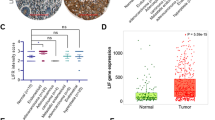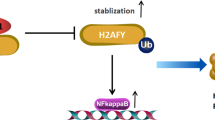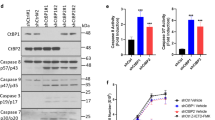Abstract
Tumor necrosis factor-related apoptosis-inducing ligand (TRAIL) has emerged as a promising antineoplastic agent because of its ability to selectively kill tumoral cells. However, some cancer cells are resistant to TRAIL-induced apoptosis. We have previously demonstrated that in endometrial carcinoma cells such resistance is caused by elevated FLICE-inhibitory protein (FLIP) levels. The present study focuses on the mechanisms by which FLIP could be modulated to sensitize endometrial carcinoma cells to TRAIL-induced apoptosis. We find that inhibition of casein kinase (CK2) sensitizes endometrial carcinoma cells to TRAIL- and Fas-induced apoptosis. CK2 inhibition correlates with a reduction of FLIP protein, suggesting that CK2 regulates resistance to TRAIL and Fas by controlling FLIP levels. FLIP downregulation correlates with a reduction of mRNA and is prevented by addition of the MG-132, suggesting that CK2 inhibition results in a proteasome-mediated degradation of FLIP. Consistently, forced expression of FLIP restores resistance to TRAIL and Fas. Moreover, knockdown of either FADD or caspase-8 abrogates apoptosis triggered by inhibition of CK2, indicating that CK2 sensitization requires formation of functional DISC. Finally, because of the possible role of both TRAIL and CK2 in cancer therapy, we demonstrate that CK2 inhibition sensitizes primary endometrial carcinoma explants to TRAIL apoptosis. In conclusion, we demonstrate that CK2 regulates endometrial carcinoma cell sensitivity to TRAIL and Fas by regulating FLIP levels.
This is a preview of subscription content, access via your institution
Access options
Subscribe to this journal
Receive 50 print issues and online access
$259.00 per year
only $5.18 per issue
Buy this article
- Purchase on Springer Link
- Instant access to full article PDF
Prices may be subject to local taxes which are calculated during checkout






Similar content being viewed by others
References
Ahmad KA, Wang G, Slaton J, Unger G, Ahmed K . (2005). Targeting CK2 for cancer therapy. Anticancer Drugs 16: 1037–1043.
Ahmed K, Gerber DA, Cochet C . (2002). Joining the cell survival squad: an emerging role for protein kinase CK2. Trends Cell Biol 12: 226–230.
Allende JE, Allende CC . (1995). Protein kinases. 4. Protein kinase CK2: an enzyme with multiple substrates and a puzzling regulation. FASEB J 9: 313–323.
Ashkenazi A, Pai RC, Fong S, Leung S, Lawrence DA, Marsters SA et al. (1999). Safety and antitumor activity of recombinant soluble Apo2 ligand. J Clin Invest 104: 155–162.
Bodmer JL, Holler N, Reynard S, Vinciguerra P, Schneider P, Juo P et al. (2000). TRAIL receptor-2 signals apoptosis through FADD and caspase-8. Nat Cell Biol 2: 241–243.
Chang L, Kamata H, Solinas G, Luo JL, Maeda S, Venuprasad K et al. (2006). The E3 ubiquitin ligase itch couples JNK activation to TNFalpha-induced cell death by inducing c-FLIP(L) turnover. Cell 124: 601–613.
Dolcet X, Llobet D, Encinas M, Pallares J, Cabero A, Schoenenberger JA et al. (2006). Proteasome inhibitors induce death but activate NF-kappaB on endometrial carcinoma cell lines and primary culture explants. J Biol Chem 281: 22118–22130.
Dolcet X, Llobet D, Pallares J, Rue M, Comella JX, Matias-Guiu X . (2005). FLIP is frequently expressed in endometrial carcinoma and has a role in resistance to TRAIL-induced apoptosis. Lab Invest 85: 885–894.
Droin N, Bichat F, Rebe C, Wotawa A, Sordet O, Hammann A et al. (2001). Involvement of caspase-2 long isoform in Fas-mediated cell death of human leukemic cells. Blood 97: 1835–1844.
Dutton A, O'Neil JD, Milner AE, Reynolds GM, Starczynski J, Crocker J et al. (2004). Expression of the cellular FLICE-inhibitory protein (c-FLIP) protects Hodgkin's lymphoma cells from autonomous Fas-mediated death. Proc Natl Acad Sci USA 101: 6611–6616.
Galligan L, Longley DB, McEwan M, Wilson TR, McLaughlin K, Johnston PG . (2005). Chemotherapy and TRAIL-mediated colon cancer cell death: the roles of p53, TRAIL receptors, and c-FLIP. Mol Cancer Ther 4: 2026–2036.
Irmler M, Steiner V, Ruegg C, Wajant H, Tschopp J . (2000). Caspase-induced inactivation of the anti-apoptotic TRAF1 during Fas ligand-mediated apoptosis. FEBS Lett 468: 129–133.
Izeradjene K, Douglas L, Delaney A, Houghton JA . (2004). Influence of casein kinase II in tumor necrosis factor-related apoptosis-inducing ligand-induced apoptosis in human rhabdomyosarcoma cells. Clin Cancer Res 10: 6650–6660.
Izeradjene K, Douglas L, Delaney A, Houghton JA . (2005). Casein kinase II (CK2) enhances death-inducing signaling complex (DISC) activity in TRAIL-induced apoptosis in human colon carcinoma cell lines. Oncogene 24: 2050–2058.
Kikkawa U, Mann SK, Firtel RA, Hunter T . (1992). Molecular cloning of casein kinase II alpha subunit from Dictyostelium discoideum and its expression in the life cycle. Mol Cell Biol 12: 5711–5723.
Kim Y, Suh N, Sporn M, Reed JC . (2002). An inducible pathway for degradation of FLIP protein sensitizes tumor cells to TRAIL-induced apoptosis. J Biol Chem 277: 22320–22329.
Kischkel FC, Lawrence DA, Chuntharapai A, Schow P, Kim KJ, Ashkenazi A . (2000). Apo2L/TRAIL-dependent recruitment of endogenous FADD and caspase-8 to death receptors 4 and 5. Immunity 12: 611–620.
Korkolopoulou P, Goudopoulou A, Voutsinas G, Thomas-Tsagli E, Kapralos P, Patsouris E et al. (2004). c-FLIP expression in bladder urothelial carcinomas: its role in resistance to Fas-mediated apoptosis and clinicopathologic correlations. Urology 63: 1198–1204.
Landesman-Bollag E, Romieu-Mourez R, Song DH, Sonenshein GE, Cardiff RD, Seldin DC . (2001). Protein kinase CK2 in mammary gland tumorigenesis. Oncogene 20: 3247–3257.
Lassus P, Opitz-Araya X, Lazebnik Y . (2002). Requirement for caspase-2 in stress-induced apoptosis before mitochondrial permeabilization. Science 297: 1352–1354.
Lavrik IN, Golks A, Baumann S, Krammer PH . (2006). Caspase-2 is activated at the CD95 death-inducing signaling complex in the course of CD95-induced apoptosis. Blood 108: 559–565.
LeBlanc HN, Ashkenazi A . (2003). Apo2L/TRAIL and its death and decoy receptors. Cell Death Differ 10: 66–75.
Lee SH, Kim HS, Kim SY, Lee YS, Park WS, Kim SH et al. (2003). Increased expression of FLIP, an inhibitor of Fas-mediated apoptosis, in stomach cancer. APMIS 111: 309–314.
Li H, Zhu H, Xu CJ, Yuan J . (1998). Cleavage of BID by caspase 8 mediates the mitochondrial damage in the Fas pathway of apoptosis. Cell 94: 491–501.
Litchfield DW . (2003). Protein kinase CK2: structure, regulation and role in cellular decisions of life and death. Biochem J 369: 1–15.
Liu X, Yue P, Schonthal AH, Khuri FR, Sun SY . (2006). Cellular FLICE-inhibitory protein down-regulation contributes to celecoxib-induced apoptosis in human lung cancer cells. Cancer Res 66: 11115–11119.
Luo X, Budihardjo I, Zou H, Slaughter C, Wang X . (1998). Bid, a Bcl2 interacting protein, mediates cytochrome c release from mitochondria in response to activation of cell surface death receptors. Cell 94: 481–490.
MacFarlane M, Ahmad M, Srinivasula SM, Fernandes-Alnemri T, Cohen GM, Alnemri ES . (1997). Identification and molecular cloning of two novel receptors for the cytotoxic ligand TRAIL. J Biol Chem 272: 25417–25420.
Padmanabha R, Chen-Wu JL, Hanna DE, Glover CV . (1990). Isolation, sequencing, and disruption of the yeast CKA2 gene: casein kinase II is essential for viability in Saccharomyces cerevisiae. Mol Cell Biol 10: 4089–4099.
Palacios C, Yerbes R, Lopez-Rivas A . (2006). Flavopiridol induces cellular FLICE-inhibitory protein degradation by the proteasome and promotes TRAIL-induced early signaling and apoptosis in breast tumor cells. Cancer Res 66: 8858–8869.
Pan G, Ni J, Wei YF, Yu G, Gentz R, Dixit VM . (1997a). An antagonist decoy receptor and a death domain-containing receptor for TRAIL. Science 277: 815–818.
Pan G, Ni J, Yu G, Wei YF, Dixit VM . (1998). TRUNDD, a new member of the TRAIL receptor family that antagonizes TRAIL signalling. FEBS Lett 424: 41–45.
Pan G, O'Rourke K, Chinnaiyan AM, Gentz R, Ebner R, Ni J et al. (1997b). The receptor for the cytotoxic ligand TRAIL. Science 276: 111–113.
Poukkula M, Kaunisto A, Hietakangas V, Denessiouk K, Katajamaki T, Johnson MS et al. (2005). Rapid turnover of c-FLIPshort is determined by its unique C-terminal tail. J Biol Chem 280: 27345–27355.
Ravi R, Bedi A . (2002). Sensitization of tumor cells to Apo2 ligand/TRAIL-induced apoptosis by inhibition of casein kinase II. Cancer Res 62: 4180–4185.
Rippo MR, Moretti S, Vescovi S, Tomasetti M, Orecchia S, Amici G et al. (2004). FLIP overexpression inhibits death receptor-induced apoptosis in malignant mesothelial cells. Oncogene 23: 7753–7760.
Seldin DC, Leder P . (1995). Casein kinase II alpha transgene-induced murine lymphoma: relation to theileriosis in cattle. Science 267: 894–897.
Sheridan JP, Marsters SA, Pitti RM, Gurney A, Skubatch M, Baldwin D et al. (1997). Control of TRAIL-induced apoptosis by a family of signaling and decoy receptors. Science 277: 818–821.
Shin S, Lee Y, Kim W, Ko H, Choi H, Kim K . (2005). Caspase-2 primes cancer cells for TRAIL-mediated apoptosis by processing procaspase-8. EMBO J 24: 3532–3542.
Son YG, Kim EH, Kim JY, Kim SU, Kwon TK, Yoon AR et al. (2007). Silibinin sensitizes human glioma cells to TRAIL-mediated apoptosis via DR5 up-regulation and down-regulation of c-FLIP and survivin. Cancer Res 67: 8274–8284.
Sprick MR, Weigand MA, Rieser E, Rauch CT, Juo P, Blenis J et al. (2000). FADD/MORT1 and caspase-8 are recruited to TRAIL receptors 1 and 2 and are essential for apoptosis mediated by TRAIL receptor 2. Immunity 12: 599–609.
Srivastava RK . (2001). TRAIL/Apo-2L: mechanisms and clinical applications in cancer. Neoplasia 3: 535–546.
Takeda K, Stagg J, Yagita H, Okumura K, Smyth MJ . (2007). Targeting death-inducing receptors in cancer therapy. Oncogene 26: 3745–3757.
Tawfic S, Yu S, Wang H, Faust R, Davis A, Ahmed K . (2001). Protein kinase CK2 signal in neoplasia. Histol Histopathol 16: 573–582.
Thome M, Schneider P, Hofmann K, Fickenscher H, Meinl E, Neipel F et al. (1997). Viral FLICE-inhibitory proteins (FLIPs) prevent apoptosis induced by death receptors. Nature 386: 517–521.
Wagner KW, Engels IH, Deveraux QL . (2004). Caspase-2 can function upstream of bid cleavage in the TRAIL apoptosis pathway. J Biol Chem 279: 35047–35052.
Walczak H, Degli-Esposti MA, Johnson RS, Smolak PJ, Waugh JY, Boiani N et al. (1997). TRAIL-R2: a novel apoptosis-mediating receptor for TRAIL. EMBO J 16: 5386–5397.
Walczak H, Miller RE, Ariail K, Gliniak B, Griffith TS, Kubin M et al. (1999). Tumoricidal activity of tumor necrosis factor-related apoptosis-inducing ligand in vivo. Nat Med 5: 157–163.
Wang G, Ahmad KA, Ahmed K . (2005a). Modulation of death receptor-mediated apoptosis by CK2. Mol Cell Biochem 274: 201–205.
Wang G, Ahmad KA, Ahmed K . (2006). Role of protein kinase CK2 in the regulation of tumor necrosis factor-related apoptosis inducing ligand-induced apoptosis in prostate cancer cells. Cancer Res 66: 2242–2249.
Wang G, Unger G, Ahmad KA, Slaton JW, Ahmed K . (2005b). Downregulation of CK2 induces apoptosis in cancer cells—a potential approach to cancer therapy. Mol Cell Biochem 274: 77–84.
Zhang X, Jin TG, Yang H, DeWolf WC, Khosravi-Far R, Olumi AF . (2004). Persistent c-FLIP(L) expression is necessary and sufficient to maintain resistance to tumor necrosis factor-related apoptosis-inducing ligand-mediated apoptosis in prostate cancer. Cancer Res 64: 7086–7091.
Acknowledgements
This study was supported by grants FIS070304, FIS070276, FIS PI020227, SAF2002-10529-E, SAF2004-05250, Marató de TV3 2005-47, and 2004XT00090, AECC, Catalunya contra el cancer and programa de intensificación de la investigación, Instituto Carlos III. XD holds a postdoctoral fellowship from the Fondo de Investigaciones Sanitarias, Ministerio de Sanidad y Consumo (CP05/00028). DLL holds a predoctoral fellowship from the Fondo de Investigaciones Sanitarias, Ministerio de Sanidad y Consumo (FI05/00191) and ME holds a Ramon y Cajal Fellowship from Ministerio de Educación y Ciencia.
Author information
Authors and Affiliations
Corresponding author
Rights and permissions
About this article
Cite this article
Llobet, D., Eritja, N., Encinas, M. et al. CK2 controls TRAIL and Fas sensitivity by regulating FLIP levels in endometrial carcinoma cells. Oncogene 27, 2513–2524 (2008). https://doi.org/10.1038/sj.onc.1210924
Received:
Revised:
Accepted:
Published:
Issue Date:
DOI: https://doi.org/10.1038/sj.onc.1210924
Keywords
This article is cited by
-
Role of protein kinase CK2 in antitumor drug resistance
Journal of Experimental & Clinical Cancer Research (2019)
-
Luteolin induces apoptosis by activating Fas signaling pathway at the receptor level in laryngeal squamous cell line Hep-2 cells
European Archives of Oto-Rhino-Laryngology (2014)
-
Inhibition of protein kinase CK2 with the clinical-grade small ATP-competitive compound CX-4945 or by RNA interference unveils its role in acute myeloid leukemia cell survival, p53-dependent apoptosis and daunorubicin-induced cytotoxicity
Journal of Hematology & Oncology (2013)
-
Endometrial carcinoma: molecular alterations involved in tumor development and progression
Oncogene (2013)
-
Inhibition of Casein kinase-2 induces p53-dependent cell cycle arrest and sensitizes glioblastoma cells to tumor necrosis factor (TNFα)-induced apoptosis through SIRT1 inhibition
Cell Death & Disease (2012)



